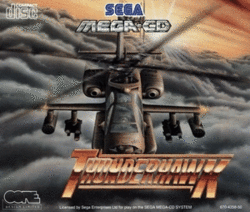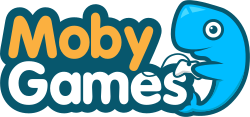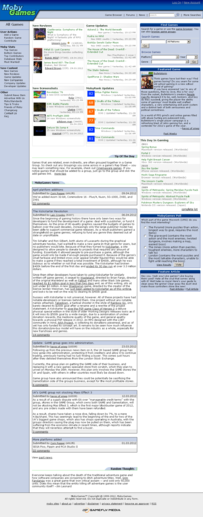Software:Thunderhawk (video game)
| Thunderhawk AH-73M | |
|---|---|
 | |
| Developer(s) | Core Design |
| Publisher(s) | Core Design (original) JVC Musical Industries (remake) |
| Producer(s) | Jeremy Heath-Smith |
| Designer(s) | Simon Phipps Mark Price Jason Gee Sean Dunlevy |
| Programmer(s) | Sarah Avory |
| Artist(s) | Jason Gee |
| Composer(s) | Martin Walker (original) Martin Iveson (remake) |
| Platform(s) | Amiga, MS-DOS, Sega CD, Atari ST |
| Release | Amiga
Sega CD |
| Genre(s) | Combat flight simulation |
| Mode(s) | Single-player |
Thunderhawk, known as AH-3 Thunderstrike in North America (in Europe known as Thunderhawk AH-73M), is a combat flight simulation video game developed and published by Core Design and released for Amiga and MS-DOS in 1992. A remake was made and published by JVC Musical Industries for Sega CD in 1993 and for MS-DOS in 1996. An Atari Jaguar CD port was planned but never released.[2][3] In the game, the player flies a fictional AH-73M attack helicopter.
Gameplay
The game consists of several campaigns for each one of ten world areas. The campaigns are themed around real events or activities in these areas (e.g. escorting a UN humanitarian convoy during the Bosnian War, fighting pirates in the South China Sea, etc.)
A typical campaign consists of four or five missions. Each mission has a primary objective that must be completed to successfully complete the mission, there are other targets in each missions such as tanks and SAM launchers but these are only used to help the player boost their score. The primary target is usually a major structure like an enemy base or a bridge.
Usually the player is equipped with a standard set of weapons - 16 missiles, 76 rockets, and a machine gun with unlimited ammunition. On some special missions the rockets are replaced by a weapon that is critical to the success of that particular mission, such as a runway cratering system when the primary objective is to destroy an airbase or a bomb when destruction of a bridge is the primary objective.
The control system for Thunderhawk was fairly unusual for the platforms supporting a mouse. It used the mouse for basic control, plus some keyboard input for rarely used commands. Moving the mouse would tilt the helicopter in the specified direction, and make it start moving in that direction. Pressing the left mouse button fires weapons. When the right mouse button was held, moving the mouse up and down changed altitude, while side to side yawed the helicopter side to side.
Reception
| Reception | ||||||||||
|---|---|---|---|---|---|---|---|---|---|---|
| ||||||||||
The game received critical acclaim, and the Mega CD version was a bestseller in the UK.[7] Mega placed the game at #1 in their Top Mega-CD Games of All Time,[8] with the sequel Battlecorps being fourth on the same list. Retro Gamer included it on their list of top ten Mega-CD games.[9] Next Generation called it the best game release for Sega CD.[10] In 1995, Flux magazine ranked the Sega CD version 27th on their "Top 100 Video Games".[11]
The game sold about 300,000 units in Europe.[12]
Sequels
Thunderhawk spawned two sequels, Firestorm and Thunderhawk. Firestorm was created using the same game engine as the original Thunderhawk.[13][14] Another Core game, Shellshock, also used the Thunderhawk engine.[10]
References
- ↑ "News: Mega CD Launches!". Edge (United Kingdom) (1): 34. October 1993.
- ↑ "Scene - Atari-News". Mega Fun (Computec Media Group GmbH & Co. KG) (29): 28. February 1995. https://retrocdn.net/index.php?title=File%3AMegaFun_DE_1995-02.pdf&page=28. Retrieved 2019-04-02.
- ↑ "Aktuelles - Hardcore". MAN!AC (Cybermedia) (17): 12. March 1995. https://archive.org/details/MANIAC.N017.1995.03.
- ↑ "Thunderhawk". Edge (2): 82–83. November 1993.
- ↑ 'MegaTech rating, EMAP, issue 5, May 1992.
- ↑ Mega review, issue 13, page 24, October 1993.
- ↑ Official Gallup UK Mega CD sales chart, March 1994, published in Mega issue 18.
- ↑ Mega magazine issue 26, page 74, Maverick Magazines, November 1994.
- ↑ "Top Ten Mega CD Games". Retrogamer.net. 11 April 2014. http://www.retrogamer.net/top_10/top-ten-mega-cd-games/.
- ↑ 10.0 10.1 "Shellshock". Next Generation (Imagine Media) (14): 86–87. February 1996.
- ↑ "Top 100 Video Games". Flux (Harris Publications) (4): 28. April 1995. https://archive.org/details/flux-issue-4/page/n27/mode/2up.
- ↑ "Interview: Jeremy Smith, Adrian Smith, Core Design". March 9, 2000. Archived from the original on February 8, 2001. https://web.archive.org/web/20010208074612/http://www.primagames.com/news/interview/1073. Retrieved August 11, 2023.
- ↑ "Blam! Machinehead". Sega Saturn Magazine (Emap International Limited) (4): 24. February 1996.
- ↑ "In the Air Tonight". Maximum: The Video Game Magazine (Emap International Limited) (2): 120–1. November 1995.
External links
- Short description: Video game database
 Logo since March 2014 | |
Screenshot  Frontpage as of April 2012[update] | |
Type of site | Gaming |
|---|---|
| Available in | English |
| Owner | Atari SA |
| Website | mobygames |
| Commercial | Yes |
| Registration | Optional |
| Launched | January 30, 1999 |
| Current status | Online |
MobyGames is a commercial website that catalogs information on video games and the people and companies behind them via crowdsourcing. This includes nearly 300,000 games for hundreds of platforms.[1] The site is supported by banner ads and a small number of people paying to become patrons.[2] Founded in 1999, ownership of the site has changed hands several times. It is currently owned by Atari SA.
Content
The database began with games for IBM PC compatibles. After two years, consoles such as the PlayStation, were added. Older console systems were added later. Support for arcade video games was added in January 2014 and mainframe computer games in June 2017.[3]
Edits and submissions go through a leisurely verification process by volunteer "approvers". The approval process can range from immediate (minutes) to gradual (days or months).[4] The most commonly used sources are the video game's website, packaging, and credit screens. There is a published standard for game information and copyediting.[5]
Registered users can rate and review any video game. Users can create private or public "have" and "want" lists which can generate a list of games available for trade with other registered users. The site contains an integrated forum. Each listed game can have its own subforum.
History

MobyGames was founded on March 1, 1999 by Jim Leonard and Brian Hirt, then joined by David Berk 18 months later, three friends since high school.[6] Leonard had the idea of sharing information about computer games with a larger audience.
In mid-2010, MobyGames was purchased by GameFly for an undisclosed amount.[7] This was announced to the community post factum and a few major contributors left, refusing to do volunteer work for a commercial website.
On December 18, 2013, MobyGames was acquired by Jeremiah Freyholtz, owner of Blue Flame Labs (a San-Francisco-based game and web development company) and VGBoxArt (a site for fan-made video game box art).[8] Blue Flame Labs reverted MobyGames' interface to its pre-overhaul look and feel.[9]
On November 24, 2021, Atari SA announced a potential deal with Blue Flame Labs to purchase MobyGames for $1.5 million.[10] The purchase was completed on 8 March 2022, with Freyholtz remaining as general manager.[11][12]
See also
- IGDB – game database used by Twitch for its search and discovery functions
References
- ↑ "MobyGames Stats". https://www.mobygames.com/moby_stats.
- ↑ "MobyGames Patrons". http://www.mobygames.com/info/patrons.
- ↑ "New(ish!) on MobyGames – the Mainframe platform.". Blue Flame Labs. 18 June 2017. http://www.mobygames.com/forums/dga,2/dgb,3/dgm,237200/.
- ↑ "MobyGames FAQ: Emails Answered § When will my submission be approved?". Blue Flame Labs. 30 March 2014. http://www.mobygames.com/info/faq7#g1.
- ↑ "The MobyGames Standards and Practices". Blue Flame Labs. 6 January 2016. http://www.mobygames.com/info/standards.
- ↑ "20 Years of MobyGames" (in en). 2019-02-28. https://trixter.oldskool.org/2019/02/28/20-years-of-mobygames/.
- ↑ "Report: MobyGames Acquired By GameFly Media". Gamasutra. 2011-02-07. http://www.gamasutra.com/view/news/32856/Report_MobyGames_Acquired_By_GameFly_Media.php.
- ↑ Corriea, Alexa Ray (December 31, 2013). "MobyGames purchased from GameFly, improvements planned". http://www.polygon.com/2013/12/31/5261414/mobygames-purchased-from-gamefly-improvements-planned.
- ↑ Wawro, Alex (31 December 2013). "Game dev database MobyGames getting some TLC under new owner". Gamasutra. http://www.gamasutra.com/view/news/207882/Game_dev_database_MobyGames_getting_some_TLC_under_new_owner.php.
- ↑ "Atari invests in Anstream, may buy MobyGames". https://www.gamesindustry.biz/articles/2021-11-24-atari-invests-in-anstream-may-buy-mobygames.
- ↑ "Atari Completes MobyGames Acquisition, Details Plans for the Site’s Continued Support". March 8, 2022. https://www.atari.com/atari-completes-mobygames-acquisition-details-plans-for-the-sites-continued-support/.
- ↑ "Atari has acquired game database MobyGames for $1.5 million" (in en-GB). 2022-03-09. https://www.videogameschronicle.com/news/atari-has-acquired-game-database-mobygames-for-1-5-million/.
Wikidata has the property:
|
External links
 |
- Short description: Video game database
 Logo since March 2014 | |
Screenshot  Frontpage as of April 2012[update] | |
Type of site | Gaming |
|---|---|
| Available in | English |
| Owner | Atari SA |
| Website | mobygames |
| Commercial | Yes |
| Registration | Optional |
| Launched | January 30, 1999 |
| Current status | Online |
MobyGames is a commercial website that catalogs information on video games and the people and companies behind them via crowdsourcing. This includes nearly 300,000 games for hundreds of platforms.[1] The site is supported by banner ads and a small number of people paying to become patrons.[2] Founded in 1999, ownership of the site has changed hands several times. It is currently owned by Atari SA.
Content
The database began with games for IBM PC compatibles. After two years, consoles such as the PlayStation, were added. Older console systems were added later. Support for arcade video games was added in January 2014 and mainframe computer games in June 2017.[3]
Edits and submissions go through a leisurely verification process by volunteer "approvers". The approval process can range from immediate (minutes) to gradual (days or months).[4] The most commonly used sources are the video game's website, packaging, and credit screens. There is a published standard for game information and copyediting.[5]
Registered users can rate and review any video game. Users can create private or public "have" and "want" lists which can generate a list of games available for trade with other registered users. The site contains an integrated forum. Each listed game can have its own subforum.
History

MobyGames was founded on March 1, 1999 by Jim Leonard and Brian Hirt, then joined by David Berk 18 months later, three friends since high school.[6] Leonard had the idea of sharing information about computer games with a larger audience.
In mid-2010, MobyGames was purchased by GameFly for an undisclosed amount.[7] This was announced to the community post factum and a few major contributors left, refusing to do volunteer work for a commercial website.
On December 18, 2013, MobyGames was acquired by Jeremiah Freyholtz, owner of Blue Flame Labs (a San-Francisco-based game and web development company) and VGBoxArt (a site for fan-made video game box art).[8] Blue Flame Labs reverted MobyGames' interface to its pre-overhaul look and feel.[9]
On November 24, 2021, Atari SA announced a potential deal with Blue Flame Labs to purchase MobyGames for $1.5 million.[10] The purchase was completed on 8 March 2022, with Freyholtz remaining as general manager.[11][12]
See also
- IGDB – game database used by Twitch for its search and discovery functions
References
- ↑ "MobyGames Stats". https://www.mobygames.com/moby_stats.
- ↑ "MobyGames Patrons". http://www.mobygames.com/info/patrons.
- ↑ "New(ish!) on MobyGames – the Mainframe platform.". Blue Flame Labs. 18 June 2017. http://www.mobygames.com/forums/dga,2/dgb,3/dgm,237200/.
- ↑ "MobyGames FAQ: Emails Answered § When will my submission be approved?". Blue Flame Labs. 30 March 2014. http://www.mobygames.com/info/faq7#g1.
- ↑ "The MobyGames Standards and Practices". Blue Flame Labs. 6 January 2016. http://www.mobygames.com/info/standards.
- ↑ "20 Years of MobyGames" (in en). 2019-02-28. https://trixter.oldskool.org/2019/02/28/20-years-of-mobygames/.
- ↑ "Report: MobyGames Acquired By GameFly Media". Gamasutra. 2011-02-07. http://www.gamasutra.com/view/news/32856/Report_MobyGames_Acquired_By_GameFly_Media.php.
- ↑ Corriea, Alexa Ray (December 31, 2013). "MobyGames purchased from GameFly, improvements planned". http://www.polygon.com/2013/12/31/5261414/mobygames-purchased-from-gamefly-improvements-planned.
- ↑ Wawro, Alex (31 December 2013). "Game dev database MobyGames getting some TLC under new owner". Gamasutra. http://www.gamasutra.com/view/news/207882/Game_dev_database_MobyGames_getting_some_TLC_under_new_owner.php.
- ↑ "Atari invests in Anstream, may buy MobyGames". https://www.gamesindustry.biz/articles/2021-11-24-atari-invests-in-anstream-may-buy-mobygames.
- ↑ "Atari Completes MobyGames Acquisition, Details Plans for the Site’s Continued Support". March 8, 2022. https://www.atari.com/atari-completes-mobygames-acquisition-details-plans-for-the-sites-continued-support/.
- ↑ "Atari has acquired game database MobyGames for $1.5 million" (in en-GB). 2022-03-09. https://www.videogameschronicle.com/news/atari-has-acquired-game-database-mobygames-for-1-5-million/.
Wikidata has the property:
|
External links
 |
Warning: Default sort key "Thunderhawk (video game)" overrides earlier default sort key "Mobygames".
 |
